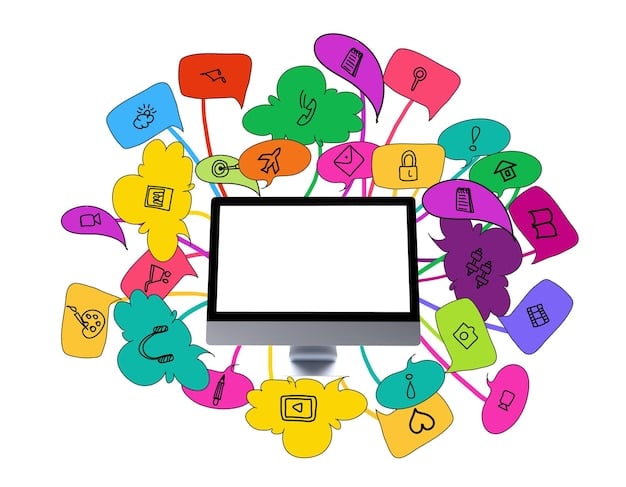Avoiding Cultural Misunderstandings in US Online Communication

Navigating the intricate landscape of US online communication requires a nuanced understanding of cultural differences to prevent misinterpretations, foster effective interactions, and build stronger digital relationships.
In today’s interconnected digital world, effective communication transcends geographical boundaries, yet navigating online interactions, especially within the United States, often presents unique cultural challenges. Understanding how to avoid cultural misunderstandings in US online communication is not just a matter of politeness; it’s essential for building rapport, fostering collaboration, and ensuring your message is received as intended.
Understanding the Layers of US Digital Culture
The digital landscape in the United States is a melting pot of communication styles, influenced by regional nuances, generational shifts, and varied professional contexts. To truly avoid cultural blunders, one must look beyond surface-level interactions and delve into the underlying cultural expectations that shape online discourse.
Initially, one might assume that online communication, being text-based, strips away many cultural markers. However, this simplification overlooks the subtle yet significant ways culture permeates digital expressions, from the choice of emojis to directness of feedback.
Directness vs. Indirectness
One of the most frequently discussed cultural axes is directness. American communication, particularly in professional settings, often favors a direct style, valuing clarity and explicit statements over subtle hints. This directness can sometimes be perceived as abrupt or overly assertive by individuals from cultures that prefer more indirect or nuanced approaches.
- Be clear and concise: Aim for statements that convey your meaning unambiguously.
- State your intentions upfront: Avoid beating around the bush when making requests or giving feedback.
- Offer constructive criticism directly: Frame feedback as helpful rather than accusatory.
Conversely, those accustomed to more indirect communication might find themselves struggling to interpret underlying messages or intentions when faced with American directness. It’s crucial for both sides to recognize these differing preferences and adjust their own communication accordingly, perhaps by adding softening language or seeking clarification when needed.
Individualism and Team Orientation
American culture often emphasizes individualism, impacting how credit is given, how decisions are made, and how personal opinions are expressed online. While collaboration is valued, individual contributions are frequently highlighted.
Understanding this balance means recognizing that while teamwork is a goal, individual accountability and initiative are highly regarded. Online, this translates into clear assignment of tasks and individual recognition for accomplishments, which might contrast sharply with collectivistic cultures where group harmony and shared credit are paramount.
When communicating, consider how your language reflects these values. Acknowledging both team effort and individual brilliance can strike the right chord.
Ultimately, a deep dive into US digital culture reveals a complex interplay of values. From the expectation of quick responses to the unwritten rules of professional email etiquette, navigating these waters requires both awareness and adaptability to prevent misunderstandings.

Navigating Language Nuances and Idioms
Beyond grammatical correctness, the English language in the US is rich with idioms, slang, and specific linguistic conventions that can easily lead to misinterpretations for non-native speakers or individuals from other English-speaking regions. Online communication, often informal and fast-paced, exacerbates this challenge.
The speed of digital interactions means there’s less time for careful phrasing or extensive clarification. This makes understanding subtle linguistic cues all the more critical.
Idiomatic Expressions and Slang
American English is replete with idioms – phrases where the meaning cannot be deduced from the literal meaning of the words. For instance, “break a leg” means good luck, not an actual injury. Online, these can appear frequently in informal chats or even business emails.
Relying heavily on such expressions without considering your audience can create barriers. A non-native speaker might spend valuable time trying to decode a phrase rather than grasping the core message.
- Minimize jargon and idioms: Especially when communicating with a diverse audience.
- If using an idiom, consider a brief explanation: “Let’s cut to the chase (get straight to the point).”
- Be mindful of slang: Slang terms can be highly regional or generational and quickly become outdated.
The informality often encouraged in online communication does not always translate to clarity. What might be perceived as friendly rapport by one person could be seen as unprofessional or even rude by another, simply due to different cultural interpretations of language use.
Tone and Emoticon Usage
The absence of non-verbal cues in text-based communication makes tone notoriously difficult to convey. Emoticons and emojis have emerged as tools to bridge this gap, but their meanings can also vary culturally.
A simple smiley face 😊 might carry different weight or even convey sarcasm in certain contexts. Overuse or inappropriate use of emojis can undermine professionalism or create confusion.
Consider the professional setting where the line between friendly chat and formal correspondence can become blurred. An emoji that a younger American colleague uses casually might be considered less appropriate by an older colleague or someone from a more formal background.
Mastering online communication involves a conscious effort to use clear, direct language, while being acutely aware of potential linguistic and tonal pitfalls. It’s about ensuring your message is not just understood, but understood correctly, without any unintended cultural baggage.
Establishing Professional Etiquette in US Online Spaces
Professional etiquette in US online communication is a fluid concept, shaped by industry, company culture, and individual preferences. However, certain underlying principles generally govern effective and respectful digital interactions, particularly in emails, video conferences, and collaborative platforms.
It’s not just about what you say, but how you say it, when you say it, and through what medium. These elements collectively contribute to the perception of your professionalism.
Email and Messaging Protocols
Emails in the US typically follow a predictable structure: a clear subject line, a greeting, concise body paragraphs, and a closing. The level of formality can vary, but brevity and clarity are almost universally appreciated.
For instance, an email lacking a clear subject line might be overlooked or misprioritized. An overly informal greeting in a first interaction could set the wrong tone. Understanding these nuances is key.
- Use clear, concise subject lines: Indicating the email’s purpose immediately.
- Be prompt with replies: Timeliness shows respect for others’ time.
- Maintain a professional tone: Even in informal exchanges, avoid offensive or overly casual language.
Instant messaging platforms, while more informal, still have unwritten rules. Expectation of immediate responses can vary, and it’s generally good practice to acknowledge messages promptly, even if just to say you’ll provide a detailed response later.
Video Conferencing Best Practices
Video conferencing has become a cornerstone of US online communication, and with it, a new set of etiquette norms has emerged. These practices are designed to ensure smooth, productive meetings and reflect professionalism.
From ensuring good lighting and a clean background to active listening and appropriate use of mute functions, these elements contribute significantly to how one is perceived in a virtual setting.
For example, not using your camera when others are, or consistently interrupting, can be viewed negatively. Conversely, being prepared, participating actively, and managing technical issues smoothly projects a professional image.
The digital age demands not just technical proficiency but also a refined understanding of digital decorum. Adhering to these established norms helps in building trust and credibility in US online professional environments.
Understanding Time and Punctuality in Digital Interactions
Perceptions of time and punctuality vary significantly across cultures, and these differences are profoundly evident in US online communication. In the fast-paced American digital sphere, ‘time is money’ is more than just a saying; it’s a deeply ingrained cultural value that influences response times, meeting schedules, and expectations for efficiency.
It’s not merely about being on time; it’s about respecting others’ time, which often translates into promptness and efficiency in all digital dealings.
Response Time Expectations
In many US professional contexts, there’s an unspoken expectation of relatively quick responses to emails and messages, especially during working hours. While “immediate” might be an exaggeration, leaving an email unanswered for days without explanation is generally frowned upon.
Consider the impact of delayed responses on project timelines or collaborative efforts. A lack of timely communication can be interpreted as a lack of engagement or even disinterest, leading to friction or missed opportunities.
- Acknowledge messages promptly: Even if you don’t have a full answer yet, a quick “Got it, will respond soon” is better than silence.
- Set realistic expectations: If you know you’ll be offline, communicate your availability to others.
- Prioritize urgent requests: Differentiate between messages requiring immediate attention and those that can wait.
The rapid nature of instant messaging often creates an expectation of even faster replies. While it’s impractical to be always online and instantly responsive, a general culture of responsiveness is highly valued.
Punctuality in Virtual Meetings
Joining virtual meetings on time is considered a fundamental aspect of professional etiquette in the US. Being late, even by a few minutes, can disrupt the flow of the meeting, signal disrespect for others’ time, and create a negative impression.
It’s common practice to join a call a few minutes early to test audio/video and be ready when the meeting officially starts. This readiness demonstrates professionalism and respect for the agenda.
Furthermore, an expectation exists that participants will be prepared for the meeting, having read any pre-circulated materials and ready to contribute to the discussion. This preparedness is another facet of respecting everyone’s time during a scheduled interaction.
Understanding and adhering to these temporal expectations are crucial for effective and culturally sensitive online communication within the US. It’s about demonstrating reliability and consideration in a digitally driven environment.

Feedback and Conflict Resolution Online
Providing and receiving feedback, as well as resolving conflicts, takes on a distinct character in US online communication. The general inclination is towards directness, but with an underlying emphasis on constructive criticism and professional decorum. Misunderstanding these norms can lead to strained relationships or unresolved issues.
The lack of in-person cues means that tone and intent can be easily misconstrued, making careful phrasing paramount.
Giving and Receiving Feedback
In many US professional settings, feedback is viewed as a mechanism for improvement and growth. It’s often given directly, but ideally with a focus on specific behaviors or outcomes rather than personal attributes.
For example, instead of saying “You’re disorganized,” a more culturally appropriate feedback might be “Your recent report lacked a clear structure, which made it difficult to follow.” This focuses on the actionable, not the inherent trait.
- Be specific and objective: Base feedback on observable actions and their impacts.
- Maintain a solution-oriented approach: Offer suggestions for improvement rather than just pointing out flaws.
- Be open to feedback yourself: Demonstrate willingness to listen and learn.
When receiving feedback, a common American response is to acknowledge it, potentially ask clarifying questions, and express appreciation, even if you don’t fully agree. Defensiveness can shut down future communication.
Addressing Disagreements and Conflicts
Online conflicts, if not handled carefully, can escalate rapidly due to the absence of immediate non-verbal cues. The preferred approach in the US often involves addressing disagreements directly yet professionally, aiming for resolution rather than avoidance.
While some cultures might prefer mediating through a third party or avoiding confrontation altogether, the US approach often leans towards direct dialogue, albeit initially through private channels rather than public forums.
If a disagreement arises, it’s generally advisable to move the discussion to a more private channel (e.g., a direct message or a one-on-one video call) rather than debating in a public group chat. This allows for more candid exchanges and reduces the risk of others misinterpreting an ongoing conflict.
Effectively navigating feedback and conflict online requires a blend of directness, empathy, and a commitment to professional resolution. It’s about building a dialogue that fosters growth and maintains respectful relationships, even when disagreements arise.
Leveraging Digital Tools for Enhanced Cultural Sensitivity
In the digital age, technology offers a myriad of tools and features that, when utilized thoughtfully, can significantly aid in preventing cultural misunderstandings in US online communication. From translation services to collaborative platforms, these tools can facilitate clarity and foster a more inclusive communication environment.
It’s not just about using the tools, but understanding how to deploy them strategically to bridge cultural divides and enhance understanding.
Translation and Language Support
While direct communication in English is often preferred, for complex topics or when dealing with highly sensitive issues, leveraging translation tools can be invaluable. However, it’s crucial to understand their limitations.
Automated translation is not perfect and can sometimes introduce its own set of misunderstandings. For critical communications, human translation or review is often recommended.
- Use built-in translation features: Many communication platforms offer these.
- Consider professional translation for key documents: Especially legal or highly technical ones.
- Offer multilingual options where feasible: For wider accessibility on websites or important notices.
Furthermore, recognizing that not everyone is a native English speaker means choosing simpler language, avoiding overly complex sentences, and being patient with response times that might be longer due to language processing.
Collaborative Platforms and Shared Practices
Collaboration tools (e.g., Slack, Microsoft Teams, Asana) provide features that can enhance cultural understanding by allowing for different communication styles and offering flexibility.
These platforms often allow for real-time clarification, rich media sharing (which can add context often lost in text), and the creation of shared documents that reduce ambiguity.
Establishing clear, shared guidelines for using these tools, emphasizing respect and understanding, can also prevent missteps. For example, agreeing on “netiquette” for team channels can pre-empt misunderstandings related to tone or response expectations.
Moreover, features like shared calendars and time zone converters directly address one of the major points of cultural misunderstanding: differing perceptions of time and punctuality. By clearly indicating availability and meeting times in local time zones, simple errors can be avoided.
Ultimately, embracing and intelligently applying these digital tools doesn’t just make communication easier; it makes it more inclusive and culturally competent, reducing the likelihood of cross-cultural errors in the US online landscape.
Building Cultural Intelligence for Online Success
Beyond specific tools and etiquette, the most robust defense against cultural misunderstandings in US online communication is the development of cultural intelligence (CQ). CQ is the ability to function effectively in culturally diverse situations, encompassing cognitive, motivational, and behavioral dimensions.
It’s not about memorizing a checklist of dos and don’ts, but rather cultivating an adaptive mindset that allows for continuous learning and adjustment in various cultural contexts.
Empathy and Perspective-Taking
At the heart of cultural intelligence lies empathy – the capacity to understand or feel what another person is experiencing from within their frame of reference. Online, this means actively trying to see situations from another individual’s cultural viewpoint.
Before reacting to a perceived slight or an unusual communication style, pause and consider alternative cultural interpretations. Could their directness be a sign of honesty, rather than rudeness? Could their silence be a sign of respect, rather than disinterest?
- Practice active listening: In online meetings, truly listen to understand, not just to reply.
- Ask open-ended questions: Encourage others to elaborate, providing more context.
- Be curious, not judgmental: Approach unfamiliar communication styles with a desire to learn.
Perspective-taking is critical because what seems logical or natural in one’s own culture may be entirely opposite in another. This awareness helps in formulating responses that are culturally appropriate and bridges gaps in understanding.
Continuous Learning and Adaptation
Cultural intelligence is not a static state but a dynamic process of continuous learning. The US cultural landscape itself is constantly evolving, influenced by new demographics, technologies, and social changes.
Staying informed about current events, popular culture, and societal norms within the US can provide valuable context for online interactions. What was acceptable a decade ago might not be today, and vice versa.
Furthermore, being open to feedback on your own communication style is essential. If someone points out a misunderstanding, approach it as a learning opportunity rather than a criticism. This willingness to adapt and refine your approach demonstrates true cultural intelligence.
Ultimately, investing in your cultural intelligence empowers you to navigate the complexities of US online communication with grace and effectiveness, turning potential misunderstandings into opportunities for deeper connection and mutual respect.
| Key Point | Brief Description |
|---|---|
| 🗣️ Direct Communication | US online interactions often favor explicit and clear messaging to avoid ambiguity. |
| ⏰ Time Sensitivity | Expectations for prompt responses and punctuality in virtual meetings are high. |
| 🤝 Professional Etiquette | Adhering to specific email formats and video conferencing norms is crucial for credibility. |
| 🧠 Cultural Intelligence | Developing empathy and a continuous learning mindset is key for effective cross-cultural online engagement. |
Frequently Asked Questions About Cultural Misunderstandings
▼
The most common issues often stem from differing expectations around directness vs. indirectness, perceptions of time and punctuality, and varied interpretations of informal language or emojis. For instance, what one culture perceives as polite indirectness, another might see as evasiveness, leading to communication breakdowns and misinterpretations of intent or urgency.
▼
American individualism often leads to a focus on individual contributions and accountability, even within team settings. While collaboration is valued, individual roles and credit are frequently emphasized. This can contrast with collectivistic cultures that prioritize group harmony and shared achievements, requiring awareness to ensure all members feel valued and understood in online projects.
▼
The appropriateness of emojis and slang in professional US online communication is highly context-dependent. While common in informal settings or internal team chats, they should be used with caution in formal interactions or with external contacts. Overuse or misinterpretation can undermine professionalism or clarity, especially when communicating with culturally diverse audiences.
▼
Digital etiquette for virtual meetings in the US typically includes punctuality, being prepared with relevant materials, active participation (often with cameras on), using mute functions to minimize distractions, and avoiding multitasking. These practices reflect respect for others’ time and the meeting’s purpose, contributing to a professional and productive virtual environment.
▼
Developing cultural intelligence involves actively seeking to understand different cultural perspectives, practicing empathy, and being open to continuous learning and adaptation. This includes researching cultural norms, observing communication styles, asking clarifying questions, and being receptive to feedback on your own interactions. It’s an ongoing process that enhances cross-cultural effectiveness.
Conclusion
Mastering online communication within the US cultural context is truly an ongoing journey that demands both awareness and adaptability. By consciously addressing differences in directness, understanding the nuances of time, adhering to professional etiquette, and leveraging digital tools thoughtfully, individuals can significantly mitigate the risk of cultural misunderstandings. Cultivating cultural intelligence allows for more meaningful connections and ensures that online interactions are not just exchanged, but truly understood and valued, paving the way for successful collaboration and stronger relationships in the digital sphere.





